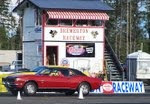

Dedicated to the Promotion and Preservation of American Muscle Cars, Dealer built Supercars and COPO cars. |
|
#1
|
|||
|
|||
|
I been reading a lot about new solid camshaft and lifter failure on start up. I have a new Comp cam in my 69 Z28. Hasn't been fired yet. A engine builder I know said he won't build a motor with a solid cam because of all the failures. Any input is appreciated.
|
|
#2
|
||||
|
||||
|
I have used a few Comp Cams in the last few years with no issue. I have used EDM lifters in the solid cams. I have one hydraulic engine out there and it seems as though all is well. We used Crower lifters in that build FWIW.
|
| The Following User Says Thank You to napa68 For This Useful Post: | ||
69M22Z (10-19-2023) | ||
|
#3
|
||||
|
||||
|
My Solid lifter motor builder performed Cam break in with reduced valve springs as a measure to assure free spining lifters during the critical break in period on the dyno. The n installed the inner springs to perform power pulls.
__________________
69 Los Z11 68 SS/RS 396/325 68 Los Z28 
|
| The Following 2 Users Say Thank You to 169indy For This Useful Post: | ||
napa68 (10-20-2023), Ryan1969Chevelle (10-20-2023) | ||
|
#4
|
||||
|
||||
|
That IS the recommended procedure by some cam manufacturers too. The guy I've had build a few engines does that too. He has a very low cam failure rate and usually it happens after the first oil change when the owner fails to head his instructions on what oil to use.
__________________
Mitch 1970 Chevelle SS 1966 Chevelle SS 1967 Camaro ss/rs 1938 Business coupe, street rod 2000 FXSTS, original owner, 13k miles |
|
#5
|
||||
|
||||
|
Quote:
Worked out Ryan W31
__________________
 1969 Beaumont 350 Auto White Sold 1969 Beaumont 307 Auto Green Sold 1969 Chevelle SS 396-L35 Auto Blue Sold 1969 Oldsmobile Cutlass 'S' Sports Coupe W31 |
|
#6
|
|||
|
|||
|
Over on the NCRS technical forum, there were a few guys with comp cams that had failures.
The consensus was don’t use Comp cams. And wasn’t there a fellow that just recently posted on here about his poor customer experience with Comp? |
|
#7
|
|||
|
|||
|
This is what I'm talking about. A recent problem. https://www.youtube.com/watch?v=72uVnPQsmjc
|
|
#8
|
|||
|
|||
|
Quote:
|
|
#9
|
||||
|
||||
|
I never had an engine go down in any of our restorations in over 25 years. Starting 3 years ago we lost almost every engine with rare exception. We had always used Comp Cam Nostalgic series cams for all of our LS6 builds and switched to other brands a couple of times after having issues with Comp. It helped but still lost two cams last year. In our case it has nothing to do with break in or oils. Simply bad material. Glad I am no longer doing them but still have one more to finish.
__________________
Rick Nelson Musclecar Restoration and Design, Inc (retired) www.musclecarrestorationanddesign.com https://www.youtube.com/watch?v=62r-6vgk2_8 specialized in (only real) LS6 Chevelle restorations Last edited by SS427; 10-20-2023 at 01:13 PM. |
|
#10
|
|||
|
|||
|
I put one of those Comp Nostalgia cams in the L71 2 years ago. No issues.
Also put one of those Nostalgia 30/30's in the DZ motor last year. That being said, it really worries me every time I put a motor together- with all the guys reporting flat tappet cam failures for the last 10 years. I also know some very reputable local race engine builders who do this for a living who have told me the same thing- never lost a cam in my life until... But I do also see other folks reporting hydraulic roller failures. So it's a crap shoot I guess. I've been very lucky- but I go to pretty extreme measures to hopefully circumvent such a situation from happening. First thing- it's very important that you verify the lifter convexity and the cam lobe taper. Ensure that the lifters do not bind in the bores- and that they do spin. Most folks do not check this- and it is critical. Most do know to remove the inner valve springs, and use a good quality break-in lube- applied liberally to all the lobes. Make sure your timing is set statically, and you are using a known good carb. Prime the motor until you see oil pumping out of every pushrod. And fill the carb float bowls with gas- so the motor fires immediately and does not crank and crank before starting. And of course, as most know- be sure to vary your RPM range over 2000-2500 for the 20 minutes of break in time. Personally, I use the Driven break-in oil, and dump it immediately after the engine is shut down- and then cut open the filter to inspect. I then put about 100 easy miles on the car, with high zinc oil- then dump the oil again and cut open the filter one more time to inspect. |
| The Following 3 Users Say Thank You to 3X24SPD For This Useful Post: | ||
 |
|
|